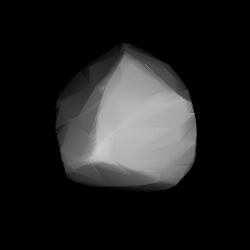Astronomy:233 Asterope
 3D model based on lightcurve data | |
| Discovery | |
|---|---|
| Discovered by | A. Borrelly |
| Discovery site | Marseille Obs. |
| Discovery date | 11 May 1883 |
| Designations | |
| (233) Asterope | |
| Pronunciation | /əˈstɛrəpiː/[1] |
| Named after | Sterope |
| A883 JA | |
| Minor planet category | Main belt |
| Orbital characteristics [2] | |
| Epoch 31 July 2016 (JD 2457600.5) | |
| Uncertainty parameter 0 | |
| Observation arc | 118.65 yr (43337 d) |
| |{{{apsis}}}|helion}} | 2.9271 astronomical unit|AU (437.89 Gm) |
| |{{{apsis}}}|helion}} | 2.3927 AU (357.94 Gm) |
| 2.6599 AU (397.92 Gm) | |
| Eccentricity | 0.10044 |
| Orbital period | 4.34 yr (1584.5 d) |
| Mean anomaly | 138.789° |
| Mean motion | 0° 13m 37.92s / day |
| Inclination | 7.6832° |
| Longitude of ascending node | 222.017° |
| 125.128° | |
| Physical characteristics | |
| Dimensions | 102.78±7.9 km |
| Rotation period | 19.70 h (0.821 d) |
| Geometric albedo | 0.0870±0.015 |
| Tholen = T [2] SMASS = K [2] | |
| Absolute magnitude (H) | 8.21[2] |
Asterope (minor planet designation: 233 Asterope) is a large main-belt asteroid that was discovered on 11 May 1883, by French astronomer Alphonse Borrelly at Marseille Observatory in Marseille, France. The asteroid was named after Asterope (or Sterope), one of the Pleiades.
This asteroid is orbiting the Sun with a semimajor axis of 2.66 astronomical unit|AU, a period of 4.34 years, and an eccentricity of 0.10. The orbital plane is inclined by 7.68° to the plane of the ecliptic. It is a rare T-type asteroid[3] and has a relatively dark surface. The spectrum of 233 Asterope bears a resemblance to Troilite, a sulfurous iron mineral found in most iron meteorites.[4]
Photometric observations during 1995 show a rotation period of 19.743 hours.[3] Measurements made with the IRAS observatory give a diameter of 109.56 ± 5.04 km and a geometric albedo of 0.08 ± 0.01. By comparison, the MIPS photometer on the Spitzer Space Telescope gives a diameter of 97.54 ± 10.32 km and a geometric albedo of 0.10 ± 0.01.[5]
References
- ↑ Noah Webster (1884) A Practical Dictionary of the English Language
- ↑ 2.0 2.1 2.2 2.3 "233 Asterope". JPL Small-Body Database. NASA/Jet Propulsion Laboratory. https://ssd.jpl.nasa.gov/sbdb.cgi?sstr=233;cad=1.
- ↑ 3.0 3.1 Piironen, J. et al. (March 1998), "Physical studies of asteroids. XXXII. Rotation periods and UBVRI-colours for selected asteroids", Astronomy and Astrophysics Supplement 128 (3): 525–540, doi:10.1051/aas:1998393, Bibcode: 1998A&AS..128..525P
- ↑ Britt, D. T. et al. (July 1992), "The Reflectance Spectrum of Troilite and the T-Type Asteroids", Meteoritics 27 (3): 207, Bibcode: 1992Metic..27Q.207B
- ↑ Ryan, Erin Lee; et al. (April 2012), "The Kilometer-Sized Main Belt Asteroid Population as Revealed by Spitzer", arXiv:1204.1116 [astro-ph.EP]
External links
- The Asteroid Orbital Elements Database
- Minor Planet Discovery Circumstances
- Asteroid Lightcurve Data File
- 233 Asterope at AstDyS-2, Asteroids—Dynamic Site
- 233 Asterope at the JPL Small-Body Database
 |

